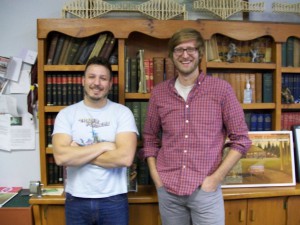
Cam Terwilliger, 2013-2014, Canada (right), with Cultural Liaison Thomas Deer (right) from the Kanien’kehá:ka Onkwawén:na Raotitióhkwa Language and Cultural Center
Ever since I graduated from my MFA in creative writing, I’ve been plugging away on a historical novel titled, Yet Wilderness Grew in My Heart. Set in colonial New York and Québec during the Seven Years War (1756-1763), it focuses on the experience of the Mohawk, the indigenous people that compose the eastern nation of the Iroquois League, a sophisticated confederacy that played a decisive role in the war. From the very start, I loved reading about Mohawk culture, as well as how this complicated people clashed and combined with Europeans on both sides of the Canadian border. However, I must admit: when it came to writing the novel itself, it was no picnic. In fact, it was quite a struggle.
As any writer will tell you, working on a long project can make you feel disconnected from life—particularly when you’re fitting it around your day job. Throughout the late nights or early mornings, you spend so much time hunched over your computer that you start to wonder why you’re doing it at all. What relevance might your writing possibly have to the world carrying on outside your window? Well—thanks to my Fulbright grant to Canada—I’m happy to say that I now have resounding answers to these questions.
Ever since I arrived in Montréal to start my Fulbright, my fiction has sprung to life in unimaginable ways. Though I’d read about the Mohawk, nothing would compare to the experience of actually visiting Kahnawà:ke, a Mohawk community that plays a pivotal role in my book. Sitting on the banks of the Saint Lawrence, Kahnawà:ke was once a Jesuit mission, but you’d never know that today. Now it blends into the contemporary landscape around Montréal, overlooking the river waves to face the city’s forest of glass and steel. The first time I set foot in Kahnawà:ke, the place instantly became so much more vivid to me. It was no longer a dimly imagined location from history. It was a living community, still evolving after hundreds of years.
Every Tuesday, I visit Kanien’kehá:ka Onkwawén:na Raotitióhkwa Language and Cultural Center, where I’m fortunate to work under the guidance of Thomas Deer, the center’s cultural liaison. In two short months, Thomas has guided me through a series of books from the center’s library, resources I never would have found on my own. It’s a treat to watch him pick out a book that will address whatever topic I might be curious about—no matter how obscure. As I’ve discovered, Thomas knows the library like the back of his hand. Always smiling, with great patience for my many questions, Thomas has educated me about many historical topics. But— more importantly—he’s taught me how these events have shaped modern Iroquois life. Thanks to him, I can see the consequences of history, how these events have reverberated up to the present.
After returning from Kahnawà:ke to Montréal, I’m left to digest this dizzying amount of knowledge. Thankfully, I have an inspiring, supportive space to do it at McGill University’s Institute for the Study of Canada. You’ll often find me on the top floor of this handsome row house on the edge of campus, writing, reviewing notes, or even just mulling over what Thomas has told me. By the end of the day, when I leave for home, my head is spinning with ideas—in the best way possible.
Fortunately for me, the Fulbright hasn’t all been work. The people of Montréal have made this a great place to live and make friends as well. It’s no secret that Montréal is a city brimming with the arts, but what I’ve found here has even exceeded my expectations. With newfound friends—both Anglophone and Francophone—I’ve gone to a host of readings, music festivals, and even a unique event called “Confabulation,” where Montrealers stand before a crowd to tell true stories of their lives without any notes whatsoever. The culture here is buzzing with ideas and creativity to say the least. In fact, I’m already making up my schedule for the Montreal International Documentary Festival next week. And the winter festival, Montréal en Lumiere, is just around the corner. In short, I couldn’t be happier to have landed here.
Tips to Prospective Fulbright Applicants:
Get in Touch with Your Alma Mater: Many people who may be interested in applying for a Fulbright have already graduated from school. This was the case for me, but after some research I discovered that my alma mater, Emerson College, would support my application regardless. I got in touch with Emerson’s “Office of Research and Creative Scholarship” and got some very helpful pointers from the staff there.
Investigate Your Fulbright Country’s Program Information: Spending a lot of time with Fulbright Canada’s homepage and the country summary allowed me to emphasize how my project fit their program. As with any application, it’s well worth understanding your audience. It’s the only way to show that your goals are aligned with theirs.
Start Early: Although the statement of grant purpose and personal statement are short documents, it will take a long time to write them. In fact, they are especially difficult because they are short. As a result, it may take many drafts to find a way to fit all the information that is necessary.
To read more about Cam Terwilliger’s Fulbright experiences, read his blog posts Field Notes from a Fulbright Scholar on The Outlet: The blog of Electric Literature.



No Comments